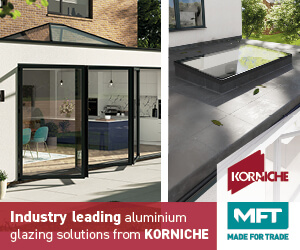By Nigel Headford – CAB CEO
The purpose of the Part L consultation in 2019 and 2020 was to gather feedback and opinions from stakeholders regarding the 2021 uplift to the Building Regulations for energy efficiency in domestic buildings in England. The document sought input on various aspects, including the U-values for glazed elements, seen as a first step towards the 2025 Future Homes Standard. The feedback informed the development of the regulations and helped shape the requirements for energy efficiency in domestic buildings, as set out in the 2021 edition of Part L that took effect in 2022.
In the Impact Assessment for the 2019/2020 Future Homes Standard consultation, ‘Part L 2020 – Option 1’, at the time gave a window U-value for a ‘notional’ dwelling of 0.8 W/m2K (g value = 0.57). This typically requires triple glazing and was seen as indicative of the proposed requirements for 2025.
All this has now changed. The current consultation for the Future Homes Standard in 2025 proposes that proof is given that every window and glazed door meets the current minimum U-value standard of 1.6 W/m²K in a new home. Currently in AD L1, as one option to demonstrate compliance, the U-value of a window can be calculated using a standard window (1.23 m x 1.48 m, with size tolerances, as per EN 14351-1). This effectively means that the U-value for only one window with a certain size and configuration needs to be calculated, allowing other windows in the range to be compliant. However from 2025, the U-value of each window will need to meet the U-value standard.
IT and tech companies in the fenestration sector will benefit from the increased demand for software to calculate U-values. The enforcement of the new compliance method is uncertain, as there has been a lack of policing in the past. There are concerns about the manipulation of configurable software and the reporting of accurate U-values. It is unclear if the final rules will be strict enough or if there will be last-minute lobbying to dilute the laws. It is proposed by government that the use of area-weighted average U-values are to be allowed for windows and doors, and it is assumed that the limiting values apply to the area-weighted values and not to individual windows or doors.
There is also a question of whether the industry will be ready by June 2025, as it takes time and testing to update products. It is possible that the Government may grant a grace period for suppliers to update their product ranges, but this will depend on the political landscape. Overall, the focus on proving compliance to U-value standards has raised many questions and uncertainties in the industry.
CAB’s draft paper of November 2024 outlined the position of the Association’s Membership regarding the likely next round of consultations for aluminium fenestration systems in domestic buildings, including the Future Homes Standard consultation for new homes, based on the 2019/2020 Impact Assessment options, although CAB’s paper was not published given the changes that transpired, as discussed earlier. According to the 2021 summary of consultation responses, 80% of respondents to the Future Homes Standard consultation thought that a home built to the Future Homes Standard, compared with the 2013 requirements, should have more than 75-80% reduction in operational CO2 emissions. The Future Homes Standard consultation responses in 2021 were dominated by architects and designers, at about 50% of the total, with participation by manufacturers/installers being almost ten times lower at about 5%, CAB have encouraged all members of the Association to respond to the latest consultation, the deadline of which has now been extended to 27th March.
There has been a drive in the construction industry to build low-carbon properties, both for dwellings and commercial buildings anticipating the 2050 deadline for carbon neutrality in the UK. The Scottish Government is planning legislation in 2024 to ensure that all new homes built in the coming years are to a Passivhaus standard, or a Scottish thermal efficiency equivalent. LETI (a Community Interest Company, ‘Low Energy Transformation Initiative’) states that building to a Passivhaus standard increases costs for new build by only 5% to 10% over current regulation construction, which should prove affordable as energy savings over time should cover the increased investment.
Currently our homes range from 90 to 170 kWh/m2/yr in operational energy usage. By 2050 our homes should be using between 40 to 60 kWh/m2/yr in operational energy usage to meet the net zero target, depending on the decarbonisation of the electricity grid. We will achieve this by taking a whole building approach to increase insulation whilst reducing air permeability and cold bridging. Obviously, we will need to stop using fossil fuels such as gas for heating as soon as practicable and move to heat pumps as the most accessible technology at the moment. Currently over 85% of homes in the UK have gas boilers. A gradual phase out of gas boilers and an increase in heat pump installations will require an increase in the electricity grid, which is also being decarbonised with the use of more renewable energy.
To achieve the net zero target, our higher insulation homes will require less energy to run and the net zero balance can be struck.
But there are implications of using more insulating materials in windows and doors such as:
Using more insulating materials inside the frames of windows and doors can make recycling more complex. This is because there are more materials to separate and sort at the end of their life. It is important to consider the recyclability and reuse potential of these materials to ensure a circular economy approach.
The use of more insulating materials in the frames of windows and doors can have implications for their performance in a fire. There may be an increased use of combustible materials, which could affect the fire resistance of the windows and doors.

More insulating materials and additional glass, such as moving from double-glazing to triple-glazing, can make the windows and doors heavier. This can lead to increased operating forces, making them more difficult to open and close. This can have implications for accessibility and usability concerns.
While lower U-values are possible with more insulating materials, the benefits in terms of reducing operational emissions may be minimal, particularly as the electricity grid decarbonises. The reduction in window U-values from 1.0 to, for example, 0.84 W/m2K may not significantly contribute to reducing operational emissions. This needs to be weighed against the other issues mentioned above, including increased embodied carbon.
It is important to strike a balance between achieving lower U-values for better operational energy efficiency and considering the practical implications and trade-offs associated with using more insulating materials in windows and doors.
Aluminium framed glazed door and window systems at the current minimum U-value standard of 1.4 W/m²K for existing homes and 1.6 W/m²K for new homes could be maintained as a short-term minimum standard, but will this be sufficient for our low-carbon future? There is already a strong Passivhaus movement in the UK and as this gathers pace together with ever increasing costs of energy, it is likely that these higher performance homes will be in demand from homeowners.
Clearly aluminium framed fenestration will continue its drive into the residential new-build and home improvement markets in the coming years. To have your voice heard you should be part of the conversation and there has never been a better time to join CAB.
Should you wish to learn more about the use of aluminium in construction, please contact CAB directly, or why not consider joining the Association and be recognised as being involved in supporting your industry and helping to shape its future. You can find more information on our website at c-a-b.org.uk













